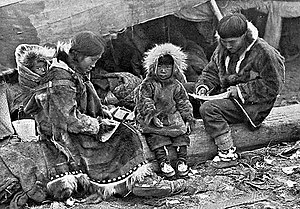 Global Information
Global InformationAttachment theory information
This article may be too long to read and navigate comfortably. (October 2023) |

An attachment theory is a psychological, evolutionary, and ethological theory concerning relationships between humans. The most important tenet is that young children need to develop a relationship with at least one primary caregiver for their survival, and for them to develop a healthy social and emotional functioning. The theory was formulated by psychiatrist and psychoanalyst John Bowlby (1907–1990).[1][2]
Within attachment theory, infant behavior associated with attachment is primarily the seeking of proximity to an attachment figure in stressful situations.[2][3] Infants become attached to adults who are sensitive and responsive in social interactions with them and who remain as consistent caregivers for some months during the period from about six months to two years of age. During the latter part of this period, children begin to use attachment figures (familiar people) as a secure base to explore from and return to. Parental responses lead to the development of patterns of attachment. These, in turn, lead to internal working models that will guide the individual's feelings, thoughts, and expectations in later relationships.[4] Separation anxiety or grief following the loss of an attachment figure is considered to be a normal and adaptive response for an attached infant. These behaviors may have evolved because they increase the probability of survival for the child.[5]
Research by developmental psychologist Mary Ainsworth in the 1960s and '70s underpinned basic concepts and topics relative to maternal responsiveness and sensitivity to infant distress.[6] She introduced the concept of the "secure base" and developed a theory of a number of attachment patterns in infants: secure attachment, avoidant attachment, and anxious attachment.[7] A fourth pattern, disorganized attachment, was identified later. In the 1980s, the theory was extended to attachment in adults.[8] Other interactions may be construed as including components of attachment behavior. These include peer relationships at all ages, romantic and sexual attraction, and responses to the care needs of infants or the sick and the elderly.
To formulate a comprehensive theory of the nature of early attachments, Bowlby explored a range of fields, including evolutionary biology, object relations theory (a school of psychoanalysis), control systems theory, and the fields of ethology and cognitive psychology.[9] After preliminary papers from 1958 onwards, Bowlby published the full theory in the trilogy Attachment and Loss (1969–82).
In the early days of the theory, academic psychologists criticized Bowlby, and the psychoanalytic community ostracized him for his departure from psychoanalytical doctrines.[10] However, attachment theory has since become the dominant approach to understanding early social development and has given rise to a great surge of empirical research into the formation of children's close relationships.[11] Later criticisms of attachment theory relate to temperament, the complexity of social relationships, and the limitations of discrete patterns for classifications. Attachment theory has been significantly modified as a result of empirical research, but the concepts have become generally accepted.[10] Attachment theory has formed the basis of new therapies and informed existing ones, and its concepts have been used in the formulation of social and childcare policies to support the early attachment relationships of children.[12]
- ^ Cassidy J (1999). "The Nature of a Child's Ties". In Cassidy J, Shaver PR (eds.). Handbook of Attachment: Theory, Research and Clinical Applications. New York: Guilford Press. pp. 3–20. ISBN 1-57230-087-6.
- ^ a b Abrams DB, Turner JR, Baumann LC, Karel A, Collins SE, Witkiewitz K, et al. (2013). "Attachment Theory". Encyclopedia of Behavioral Medicine. New York, NY: Springer New York. pp. 149–155. doi:10.1007/978-1-4419-1005-9_939. ISBN 978-1-4419-1004-2.
Bowlby (1969, 1988) described an attachment as an emotional bond that is characterized by the tendency to seek out and maintain proximity to a specific attachment figure, particularly during times of distress.
- ^ Brimhall AS, Haralson DM (2017). "Bonds in Couple and Family Therapy". Encyclopedia of Couple and Family Therapy. Cham: Springer International Publishing. pp. 1–3. doi:10.1007/978-3-319-15877-8_513-1. ISBN 978-3-319-15877-8.
Bond is an emotional attachment between one or more individuals. To be considered an attachment bond, the relationship must have four defining characteristics: proximity maintenance, separation distress, safe haven, and secure base.
- ^ Bretherton I, Munholland KA (1999). "Internal Working Models in Attachment Relationships: A Construct Revisited". In Cassidy J, Shaver PR (eds.). Handbook of Attachment:Theory, Research and Clinical Applications. New York: Guilford Press. pp. 89–114. ISBN 1-57230-087-6.
- ^ Prior & Glaser 2006, p. 17.
- ^ Bernard K, Meade E, Dozier M (November 2013). "Parental synchrony and nurturance as targets in an attachment based intervention: building upon Mary Ainsworth's insights about mother–infant interaction". Attachment & Human Development. 15 (5–6): 507–523. doi:10.1080/14616734.2013.820920. ISSN 1461-6734. PMC 3855268. PMID 24299132.
- ^ Bretherton I (1992). "The Origins of Attachment Theory: John Bowlby and Mary Ainsworth". Developmental Psychology. 28 (5): 759–775. doi:10.1037/0012-1649.28.5.759.
- ^ Hazan C, Shaver P (March 1987). "Romantic love conceptualized as an attachment process". Journal of Personality and Social Psychology. 52 (3): 511–24. doi:10.1037/0022-3514.52.3.511. PMID 3572722. S2CID 2280613.
- ^ Simpson JA (1999). "Attachment Theory in Modern Evolutionary Perspective". In Cassidy J, Shaver PR (eds.). Handbook of Attachment:Theory, Research and Clinical Applications. New York: Guilford Press. pp. 115–40. ISBN 1-57230-087-6.
- ^ a b Cite error: The named reference
Rutter 95was invoked but never defined (see the help page). - ^ Cite error: The named reference
Schafferwas invoked but never defined (see the help page). - ^ Cite error: The named reference
BZLwas invoked but never defined (see the help page).